Tigrinya may refer to:
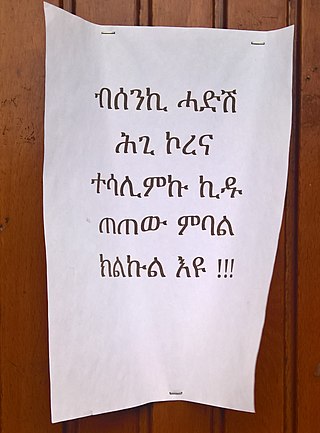
Tigrinya is an Ethio-Semitic language commonly spoken in Eritrea and in northern Ethiopia's Tigray Region by the Tigrinya and Tigrayan peoples respectively. It is also spoken by the global diaspora of these regions.

The Tigray Region is the northernmost regional state in Ethiopia. The Tigray Region is the homeland of the Tigrayan, Irob and Kunama people. Its capital and largest city is Mekelle. Tigray is the fifth-largest by area, the fourth-most populous, and the fifth-most densely populated of the 11 regional states.
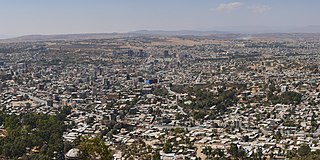
Mekelle, or Mek'ele, is a special zone and capital of the Tigray Region of Ethiopia. Mekelle was formerly the capital of Enderta awraja in Tigray. It is located around 780 kilometres (480 mi) north of the Ethiopian capital Addis Ababa, with an elevation of 2,254 metres (7,395 ft) above sea level. Administratively, Mekelle is considered a Special Zone, which is divided into seven sub-cities. It is the economic, cultural, and political hub of northern Ethiopia.
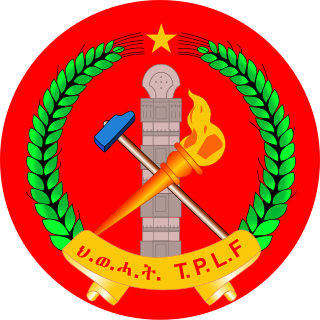
The Tigray People's Liberation Front, also known as the Tigrayan People's Liberation Front, is a left-wing ethnic nationalist, paramilitary group, and the former ruling party of Ethiopia. It was classified as a terrorist organization by the Ethiopian government during the Tigray War until its removal from the list in 2023. In older and less formal texts and speech it is known as Woyane or Weyané.
Tigray may refer to:
Tigray Province, also known as Tigre, was a historical province of northern Ethiopia that overlayed the present day Afar and Tigray regions. Akele Guzai borders with the Tigray province. It encompassed most of the territories of Tigrinya-speakers in Ethiopia. Tigray was separated from the northern Tigrinya speaking territories by the Mareb River, now serving as the state border to Eritrea, bordering Amhara region in the south.
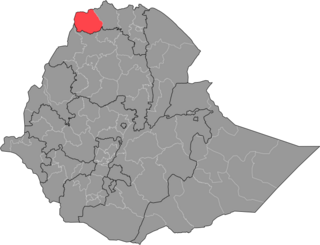
The Western Zone is a zone in the Tigray Region of Ethiopia. It is subdivided into three woredas (districts); from north to south they are Kafta Humera, Welkait and Tsegede. The largest town is Humera. The Western Zone is bordered on the east by the North Western Zone, the south by the Amhara Region, the west by Sudan and on the north by Eritrea. Starting from the late 17th C., internal boundaries are clearly shown, with 37 maps displaying a boundary that is located well south of the Tekeze River, or even south of the Simien mountains. Welkait is explicitly included within a larger Tigray confederation ; it is briefly mapped as part of Amhara in 1891–1894 and part of Gondar from 1944 to 1990. At other periods it appears independent or part of a larger Mezaga lowland region.

Tigrayans are a Semitic-speaking ethnic group indigenous to the Tigray Region of northern Ethiopia. They speak the Tigrinya language, an Afroasiatic language belonging to the Ethiopian Semitic branch.
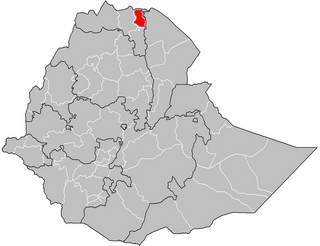
The Eastern Zone is a zone in the Tigray Region of Ethiopia. It is bordered on the east by the Afar Region, on the south by the South Eastern Zone, on the west by the Central Zone and on the north by Eritrea. Its highest point is Mount Asimba. Towns and cities in the Eastern Zone include Adigrat, Atsbi, Hawzen, and Wukro.

The Southern Zone is a zone in the Tigray Region of Ethiopia. The Southern Zone is bordered on the south and west by the Amhara Region, on the north by the Central Zone, and on the east by the Afar Region. Towns and cities in the Southern Zone include Maychew, Korem, Zata and Alamata. The South Eastern Zone was separated from the Southern Zone.

Tselemti is an Ethiopian District, or woreda, in the Tigray Region of Ethiopia. Part of the Semien Mi'irabawi Zone, Tselemti is bordered on the south by the Amhara Region, on the west by the Mi'irabawi Zone, on the north by Asigede Tsimbela, on the northeast by Medebay Zana, and on the east by the Maekelay Zone. The Tekezé defines the boundary between Tselemti and both the last two woredas and the Zone; other rivers in this woreda include the Abata, a tributary of the Tekezé. The administrative center of this woreda is Mai Tsebri; other towns in Tselemti include Dima.
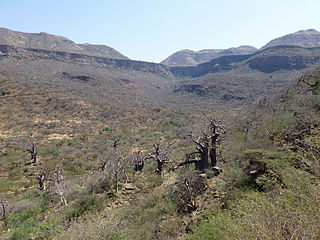
Saharti Samre is one of the Districts of Ethiopia, or woredas, in the Tigray Region of Ethiopia. Part of the Debub Misraqawi (Southeastern) Zone, Samre is bordered on the south by the Amhara Region, on the west and north by the Mehakelegnaw (Central) Zone, on the northeast by Enderta, on the east by Hintalo Wajirat, and on the southeast by Debubawi (Southern) Zone. Towns in this woreda include Gijet and Samre.
Articles related to Ethiopia include:

The North Western Zone is a zone in Tigray Region of Ethiopia. It is bordered on the east by the Central Zone, the south by the Amhara Region, the west by the Western Zone and on the north by Eritrea. The Zone is subdivided into the six woredas (districts), which are Asgede, Tsimbla, La'ilay Adiyabo, Medebay Zana, Tahtay Adiyabo, Tahtay Koraro and Tselemti. Major towns and cities in the zone include Shire, Sheraro, Inda Aba Guna, Selekleka, Adi Daero, May Tsebri. The North Western Zone was split off from Western Zone in 2005.
Tigrayan-Tigrinya people or Tigray-Tigrinya people most often refers to two closely linked but different ethnographic groups of Ethiopia and Eritrea who traditionally speak the Tigrinya language:

Siwa, Amharic: ጠላ, is a beer originating from Tigray. Traditionally home-brewed, siwa remains locally popular during social events, after (manual) work, and as an incentive for farmers and labourers. Thousands of traditional beer houses straddle the Tigrayan urban and rural landscapes.

The Tigrinya people, also known as the Biher-Tigrinya or Kebessa, are an ethnic group indigenous to Eritrea. They speak the Tigrinya language. There also exists a sizable Tigrinya community in the diaspora.

Salsay Weyane Tigray is a political party in the Tigray Region of Ethiopia.
Yikono is a grassroots women's rights group based in Tigray Region in Ethiopia that is opposed to gender-based violence.

Tigrayan nationalism is an ethnic nationalism that advocates the interests of Tigrayan people in Ethiopia. Inspired predominantly by the Tigray People's Liberation Front (TPLF) with its predecessor Tigray Liberation Front (TLF), this type of nationalism holds that Tigrayans are an independent group with unique ancestry, heritage, history and culture outside Ethiopia. As such, they claim Tigray is the source of Ethiopian civilization and utterly a benefactor of state-building without other local ethnic groups. Tigrayan nationalists accuse Amharas of imposing their cultural, economic and political hegemony over Tigrayans.